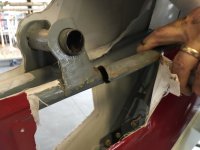Several weeks ago, I flew my PA-12 to Whiteplains Airpark (SC99), Gilbert, SC to check on the PA-18 Ed Fisher is rebuilding for me. Just as I'm getting out of the plane, Ed's sharp eye caught some wrinkles in the fabric on the right side of the tail. Removing inspection panels and the tail clean out pan revealed that the right upper longeron was completely broken just forward of the Stabilizer Support Assy. It had been broken long enough to cause some serious fretting. After tearing fabric away, Ed also found that a crack had started on the left side in the same place. I don't know how this would have ended up if Ed had not found this. Hopefully it would have failed on a landing but could have been much worse!
On the PA-18 that Ed is working on, the left longeron had been repaired in the same place and Ed found a small crack on the right side, same place.
I did a search and found a thread started in Jan/2003
What Breaks?...Common faults, not commonly known.
The third posting on this thread by SuperCub MD lists this as a common problem area.
I would urge everyone to check their Cub longerons at this location for cracks. I had no idea anything was wrong back there.
The horiz stab does a lot of shaking and twisting a lot of it is transferred to the longerons by the support assy. Once a crack starts, it likely progresses rapidly.
Incidentally, while there was some surface corrosion inside the tubing, it was structurally sound and not a factor in the breakage.
In addition to the repairing of the broken areas( smaller tube inside, rosette welding, etc) Ed devised a fix to reinforce this area. He installed 3/8" Chromoly stiff legs that go underneath each longeron from the support assy to the intersection of bracing below. See Picture.
Perhaps someone else has encountered this problem and come up with a fix. If so, I would be interested to see what has been done. Ed is doing the same reinforcement to the PA-18 fuselage.
On the PA-18 that Ed is working on, the left longeron had been repaired in the same place and Ed found a small crack on the right side, same place.
I did a search and found a thread started in Jan/2003
What Breaks?...Common faults, not commonly known.
The third posting on this thread by SuperCub MD lists this as a common problem area.
I would urge everyone to check their Cub longerons at this location for cracks. I had no idea anything was wrong back there.
The horiz stab does a lot of shaking and twisting a lot of it is transferred to the longerons by the support assy. Once a crack starts, it likely progresses rapidly.
Incidentally, while there was some surface corrosion inside the tubing, it was structurally sound and not a factor in the breakage.
In addition to the repairing of the broken areas( smaller tube inside, rosette welding, etc) Ed devised a fix to reinforce this area. He installed 3/8" Chromoly stiff legs that go underneath each longeron from the support assy to the intersection of bracing below. See Picture.
Perhaps someone else has encountered this problem and come up with a fix. If so, I would be interested to see what has been done. Ed is doing the same reinforcement to the PA-18 fuselage.




